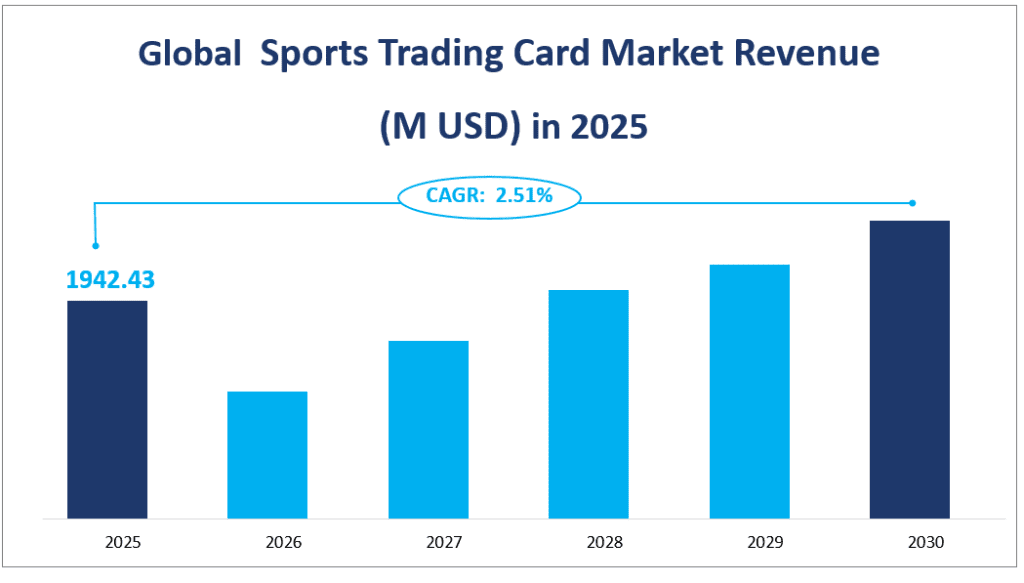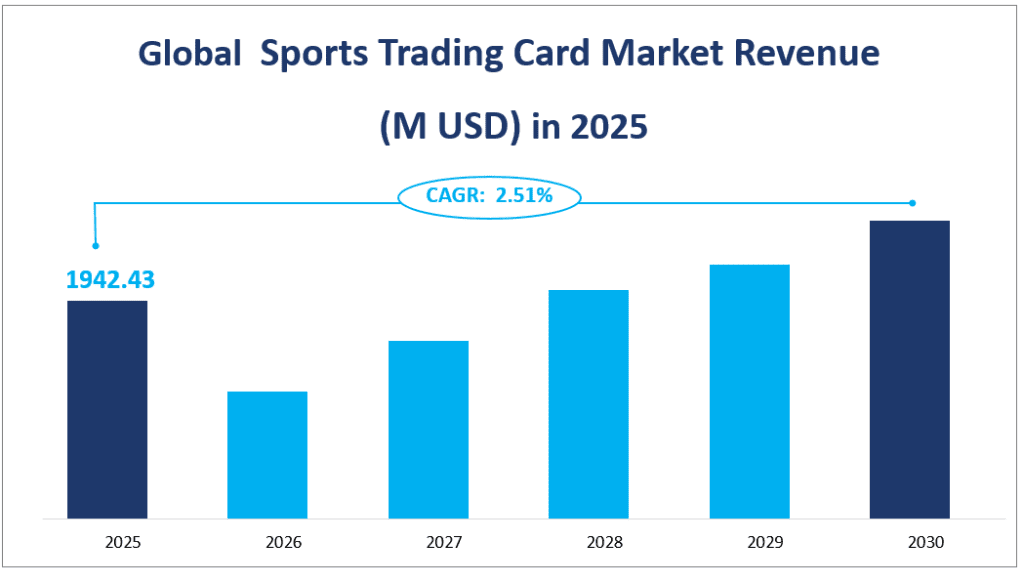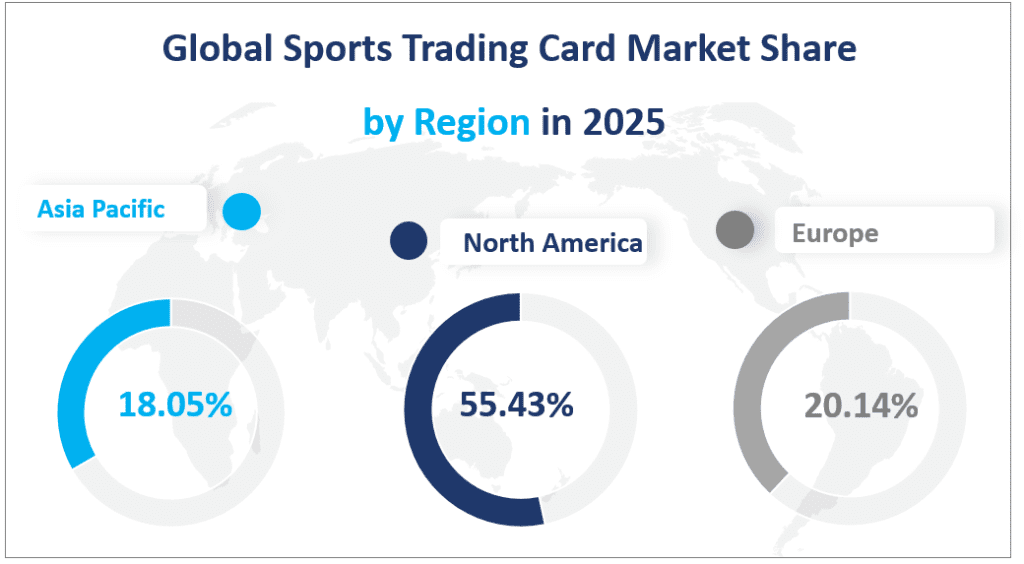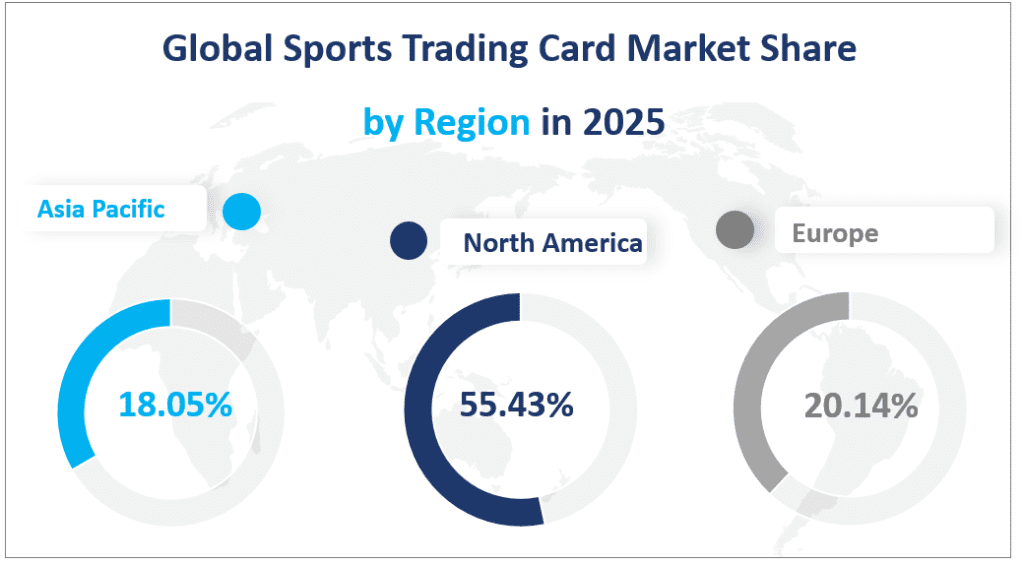1. Global Sports Trading Card Market Definition
The global sports trading card market is projected to reach a value of $1,942.43 million in 2025 with a CAGR of 13.60% from 2025 to 2030.
Sports trading cards are collectible items that feature images and statistics of athletes or sports teams. They can be categorized into two main types: physical trading cards and digital trading cards. Physical trading cards are tangible items, often made from high-quality materials, and are popular among traditional collectors. Digital trading cards, on the other hand, exist in virtual formats and have gained significant traction with the rise of digital platforms and blockchain technology. The market is also segmented by application, covering various sports such as American football, baseball, basketball, football, hockey, and others.
Global Sports Trading Card Market Revenue (M USD) in 2025


2. Driving Factors of Sports Trading Card Market
The growth of the global sports trading card market is driven by several key factors. Firstly, the resurgence in popularity of sports trading cards has been fueled by nostalgia, as many collectors have fond memories of collecting cards during their childhood. This emotional connection has led to a revival in the hobby, attracting both experienced collectors and newcomers. Additionally, the rise of social media and influencers has played a crucial role in promoting sports trading cards. Celebrities, athletes, and content creators have used their platforms to showcase their collections, inspiring their followers to join the trend.
Another significant driver is the increasing interest in alternative investments. Sports trading cards have emerged as a viable investment option, with some vintage cards fetching impressive prices at auction. This has attracted mainstream media attention and piqued the interest of potential investors. The limited production of certain cards, especially those featuring superstar players or unique designs, has further enhanced their scarcity and investment value.
3. Limiting Factors of the Sports Trading Card Market
However, the market also faces several limiting factors. One of the primary challenges is the uncertainty surrounding the future value of sports trading cards. The market’s reliance on nostalgia and consumer interest means that its growth is subject to fluctuations in public sentiment. Additionally, the emergence of counterfeit cards poses a significant threat to the market’s integrity. Low-quality fake cards can undermine consumer trust and disrupt the market’s stability.
Another limiting factor is the competition from other collectible markets. The younger generation is increasingly drawn to trading card games such as Yu-Gi-Oh and Pokémon, which offer social and competitive elements that appeal to a broader audience. This competition may slow the growth of the sports trading card market among younger consumers. Furthermore, the rising prices of sports trading cards and the lack of consumer knowledge about the market can act as barriers to entry for new collectors.
4. Global Sports Trading Card Market Segment
Product Types
In 2025, the market sales value for physical sports trading cards is projected to reach $1604.67 million. These cards have long been a staple in the collectibles market, appealing to traditional collectors who value the tactile experience of holding and displaying physical cards. Made from high-quality materials and often featuring intricate designs, physical cards remain a dominant force in the market.
The digital segment is expected to achieve a market sales value of $337.76 million in 2025. Digital trading cards have gained significant traction in recent years, driven by advancements in technology and the rise of digital platforms. These virtual collectibles offer convenience, accessibility, and innovative features such as NFTs (non-fungible tokens) that enhance their appeal to modern collectors.
The dominance of physical sports trading cards in the market can be attributed to several factors. Firstly, physical cards have a long-standing history and cultural significance, making them a cherished item for collectors. Their tangible nature allows for display and personal interaction, which is a key aspect of the collecting experience. Additionally, physical cards often come with unique features such as autographs, memorabilia inserts, and limited-edition releases, which enhance their collectible value and appeal to both casual collectors and serious investors.
Market by Application
The market sales value for American football trading cards is projected to reach $567.86 million in 2025. American football enjoys a large and passionate fan base, particularly in the United States, which drives demand for collectible cards featuring NFL players and teams.
Baseball trading cards are expected to achieve a market sales value of $227.91 million in 2025. Baseball has a rich history of trading card collections, and its enduring popularity ensures a steady demand for cards featuring MLB players and iconic moments from the sport.
The basketball segment is projected to reach $347.22 million in 2025. The global popularity of basketball, fueled by the NBA and international leagues, has led to a significant increase in the demand for basketball trading cards. The sport’s dynamic nature and star players make it a favorite among collectors.
Football trading cards are expected to achieve a market sales value of $423.69 million in 2025. As the most popular sport globally, football has a massive fan base that drives strong demand for collectible cards featuring players from top leagues such as the Premier League, La Liga, and Serie A.
The market sales value for hockey trading cards is projected to reach $159.53 million in 2025. Hockey enjoys a dedicated fan base, particularly in North America and Europe, which supports a steady market for collectible cards featuring NHL players and teams.
Market Sales in Value by Segment
| Sales in Value (M USD) in 2025 | ||
| By Type | Physical Sports Trading Card | 1604.67 |
| Digital Sports Trading Card | 337.76 | |
| By Application | American Football | 567.86 |
| Baseball | 227.91 | |
| Basketball | 347.22 | |
| Association | 423.69 | |
| Football | 159.53 | |
| Hockey | 216.22 |
5. Regional Sports Trading Card Market
North America is projected to remain the largest regional market for sports trading cards in 2025, with sales valued at $1076.72 million. The region’s dominance can be attributed to its strong sports culture, particularly in the United States, where sports like American football, baseball, and basketball have a massive following. The presence of major leagues such as the NFL, MLB, and NBA provides a steady stream of content for trading cards, fueling consumer demand. Additionally, North America has a well-established collector base and a robust infrastructure for the production and distribution of trading cards.
Europe is expected to achieve a market sales value of $391.24 million in 2025. The region’s market is driven by the popularity of football (soccer), which enjoys widespread fan support across countries like the UK, Germany, France, and Italy. European football leagues, such as the English Premier League and La Liga, are among the most-watched sports events globally, contributing significantly to the demand for trading cards. Europe also benefits from a growing digital market, with platforms increasingly offering digital trading cards and NFTs.
The Asia-Pacific region is projected to reach a market sales value of $272.93 million in 2025. While still smaller compared to North America and Europe, the region is experiencing rapid growth, driven by the increasing popularity of sports such as basketball, football, and baseball. The region’s growth is further supported by the adoption of digital platforms and the rise of e-sports, which are creating new opportunities for trading card manufacturers.
Latin America is expected to achieve a market sales value of $132.46 million in 2025. The region’s market is driven by the passion for football and baseball, particularly in countries like Brazil, Mexico, and Argentina. The growing middle class and increasing urbanization are contributing to the demand for sports trading cards. Additionally, the region is benefiting from the expansion of digital platforms, which are making trading cards more accessible to a broader audience.
Global Sports Trading Card Market Share by Region in 2025


6. Top 3 Companies in the Global Sports Trading Card Market
Company Introduction and Business Overview:
Panini is a leading global manufacturer of sports trading cards and collectibles, founded in 1961 in Italy. The company is renowned for its high-quality products, which include stickers, trading cards, albums, and certified authentic memorabilia. Panini operates worldwide and has a strong presence in major markets such as North America, Europe, and Asia-Pacific. The company’s success is attributed to its innovative product offerings, strong licensing agreements with major sports leagues, and a robust distribution network. Panini is also known for its commitment to technological innovation, leveraging digital platforms and blockchain technology to enhance the collectible experience.
Products Offered:
Panini offers a wide range of sports trading cards, covering various sports such as football (soccer), basketball, American football, and others. Their product lineup includes popular collections like Panini Prizm, Panini Select, and Panini Flawless, which feature high-quality cards with autographs, memorabilia inserts, and limited-edition releases. Panini also produces digital trading cards and NFTs, leveraging blockchain technology to enhance the collectible experience.
Company Introduction and Business Overview:
Topps Company, founded in 1938 in the United States, is a well-established player in the sports trading card market. The company is known for its extensive range of trading cards, stickers, and collectibles. Topps has a strong presence in North America and Europe and has recently expanded its digital offerings through partnerships and acquisitions. The company’s success is driven by its long-standing relationships with major sports leagues and its innovative product development. Topps was acquired by Fanatics in 2022, which has further expanded its digital presence and licensing rights.
Products Offered:
Topps offers a diverse range of sports trading cards, covering sports such as baseball, basketball, American football, and others. Their product lineup includes popular collections like Topps Bowman, Topps Chrome, and Topps Series 1, which feature high-quality cards with autographs, memorabilia inserts, and limited-edition releases. Topps has also ventured into digital trading cards and NFTs, leveraging blockchain technology to enhance the collectible experience.
Company Introduction and Business Overview:
The Upper Deck Company, founded in 1988 in the United States, is a leading manufacturer of sports trading cards and collectibles. The company is known for its high-quality products, which include trading card sets, sports checklists, games, and memorabilia. Upper Deck operates primarily in North America and has a strong presence in the European market. The company’s success is attributed to its innovative product offerings, strong licensing agreements with major sports leagues, and a commitment to authenticity and quality. Upper Deck is also known for its collaborations with major sports leagues and entertainment franchises.
Products Offered:
Upper Deck offers a wide range of sports trading cards, covering various sports such as basketball, football, golf, hockey, and soccer. Their product lineup includes popular collections like Upper Deck MVP Hockey Cards, which feature high-quality cards with autographs, memorabilia inserts, and limited-edition releases. Upper Deck has also ventured into digital trading cards and NFTs, leveraging blockchain technology to enhance the collectible experience.
Major Players
| Company Name | Headquarters | Sales Regions |
| Panini | Italy | Worldwide |
| Topps Company | USA | Worldwide |
| The Upper Deck Company | USA | Mainly in North America |
| Leaf Trading Cards | USA | Mainly in North America and Asia |
| Tristar Productions | USA | Mainly in North America |
| Futera | UAE | Worldwide |
1 Study Coverage
1.1 Sports Trading Card Product Introduction
1.2 Global Sports Trading Card Outlook 2018 VS 2023 VS 2031
1.3 Sports Trading Card Market Size, United States VS Global,2018 VS 2023 VS 2031
1.3.1 The Market Share of United States Sports Trading Card in Global, 2018 VS 2023 VS 2031
1.3.2 The Growth Rate of Sports Trading Card Market Size, United States VS Global, 2018 VS 2023 VS 2031
1.4 Sports Trading Card Market Dynamics
1.4.1 Sports Trading Card Market Trends
1.4.2 Sports Trading Card Market Drivers
1.4.3 Sports Trading Card Market Challenges
1.4.4 Sports Trading Card Market Restraints
1.5 Study Objectives
1.6 Years Considered
2 Sports Trading Card by Type
2.1 Sports Trading Card Market Segment by Type
2.1.1 Physical Sport Trading Card
2.1.2 Digital Sport Trading Card
2.2 Global Sports Trading Card Market Size by Type (2018, 2023 & 2031)
2.3 Global Sports Trading Card Market Size by Type (2018-2031)
2.4 United States Sports Trading Card Market Size by Type (2018 & 2023 & 2031)
2.5 United States Sports Trading Card Market Size by Type (2018-2031)
3 Sports Trading Card by Application
3.1 Sports Trading Card Market Segment by Application
3.1.1 Sports Trading Card Market Segment by Application
3.2 Global Sports Trading Card Market Size by Application (2018 & 2023 & 2031)
3.3 Global Sports Trading Card Market Size by Application (2018-2031)
3.4 United States Sports Trading Card Market Size by Application (2018 & 2023 & 2031)
3.5 United States Sports Trading Card Market Size by Application (2018-2031)
4 Global Sports Trading Card Competitor Landscape by Company
4.1 Global Sports Trading Card Market Size by Company
4.1.1 Top Global Sports Trading Card Manufacturers Ranked by Revenue (2022)
4.1.2 Global Sports Trading Card Revenue by Manufacturer (2018-2023)
4.2 Global Sports Trading Card Concentration Ratio (CR)
4.2.1 Sports Trading Card Market Concentration Ratio (CR) (2018-2023)
4.2.2 Global Top 2 and Top 3 Largest Manufacturers of Sports Trading Card in 2022
4.2.3 Global Sports Trading Card Market Share by Company Type (Tier 1, Tier 2, and Tier
4.3 Global Sports Trading Card Manufacturing Base and Distribution
4.3.1 Global Sports Trading Card Manufacturers, Headquarters and Distribution of Producing Region
4.3.2 Manufacturers Sports Trading Card Establishment time
4.4 Manufacturers Mergers & Acquisitions, Expansion Plans
4.5 United States Sports Trading Card Market Size by Company
4.5.1 Top United States Sports Trading Card Manufacturer s Ranked by Revenue (2022)
5 Global Sports Trading Card Market Size by Region
5.1 Global Sports Trading Card Market Size by Region: 2018 VS 2023 VS 2031
5.2 Global Sports Trading Card Market Size in Value by Region (2018-2031)
5.2.1 Global Sports Trading Card Sales in Value by Region: 2018-2023
5.2.2 Global Sports Trading Card Sales in Value by Region: 2024-2031
6 Segment in Regional Level & Country Level
6.1 North America
6.1.1 North America Sports Trading Card Market Size YoY Growth 2018-2031
6.1.2 North America Sports Trading Card Market Facts & Figures by Country (2018 & 2023 & 2031)
6.1.3 U.S.
6.1.4 Canada
6.2 Asia Pacific
6.2.1 Asia Pacific Sports Trading Card Market Size YoY Growth 2018-2031
6.2.2 Asia Pacific Sports Trading Card Market Facts & Figures by Country (2018 & 2023 & 2031)
6.2.3 China
6.2.4 Japan
6.2.5 South Korea
6.2.6 India
6.2.7 Australia
6.2.8 Southeast Asia
6.3 Europe
6.3.1 Europe Sports Trading Card Market Size YoY Growth 2018-2031
6.3.2 Europe Sports Trading Card Market Facts & Figures by Country (2018, 2023 & 2031)
6.3.3 Germany
6.3.4 France
6.3.5 UK
6.3.6 Italy
6.3.7 Russia
6.3.8 Spain
6.4 Latin America
6.4.1 Latin America Sports Trading Card Market Size YoY Growth 2018-2031
6.4.2 Latin America Sports Trading Card Market Facts & Figures by Country (2018, 2023 & 2031)
6.4.3 Mexico
6.4.4 Brazil
6.4.5 Argentina
6.5 Middle East and Africa
6.5.1 Middle East and Africa Sports Trading Card Market Size YoY Growth 2018-2031
6.5.2 Middle East and Africa Sports Trading Card Market Facts & Figures by Country (2018, 2023 & 2031)
6.5.3 GCC Countries
6.5.4 Africa
7 Company Profiles
7.1 Panini
7.1.1 Panini Company Details
7.1.2 Description and Business Overview
7.1.3 Sports Trading Card Introduction
7.1.4 Panini Sports Trading Card Revenue, Gross, and Gross Margin (2018-2023)
7.1.5 Panini Recent Development
7.2 Topps Company
7.2.1 Topps Company Details
7.2.2 Description and Business Overview
7.2.3 Sports Trading Card Introduction
7.2.4 Topps Company Sports Trading Card Revenue, Gross, and Gross Margin (2018-2023)
7.2.5 Topps Company Recent Development
7.3 The Upper Deck Company
7.3.1 The Upper Deck Company Details
7.3.2 Description and Business Overview
7.3.3 Sports Trading Card Introduction
7.3.4 The Upper Deck Company Sports Trading Card Revenue, Gross, and Gross Margin (2018-2023)
7.3.5 The Upper Deck Company Recent Development
7.4 Leaf Trading Cards
7.4.1 Leaf Trading Cards Company Details
7.4.2 Description and Business Overview
7.4.3 Sports Trading Card Introduction
7.4.4 Leaf Trading Cards Sports Trading Card Revenue, Gross, and Gross Margin (2018-2023)
7.4.5 Leaf Trading Cards Recent Development
7.5 Tristar Productions
7.5.1 Tristar Productions Company Details
7.5.2 Description and Business Overview
7.5.3 Sports Trading Card Introduction
7.5.4 Tristar Productions Sports Trading Card Revenue, Gross, and Gross Margin (2018-2023)
7.6 Futera
7.6.1 Futera Company Details
7.6.2 Description and Business Overview
7.6.3 Sports Trading Card Introduction
7.6.4 Futera Sports Trading Card Revenue, Gross, and Gross Margin (2018-2023)
7.6.5 Futera Recent Development
8 Research Findings and Conclusion
9 Appendix
9.1 Methodology
9.2 Research Data Source
9.2.1 Secondary Data
9.2.2 Primary Data
9.2.3 Market Size Estimation
9.2.4 Legal Disclaimer
